Allard Register #67
/Please click here or the photo above to download the latest issue of the Allard Register, we hope you enjoy it! Cheers, Colin
If you find a story below interesting, please click the "Like" button...Thank You!
Please click here or the photo above to download the latest issue of the Allard Register, we hope you enjoy it! Cheers, Colin
It’s with a heavy heart that we say goodbye to the last of the great Allard racers. Bill Pollack took his last checkered flag in July 16 at the age of 92. Bill was born on July 7, 1925 in New York to Lew and Helen Pollack. The family moved out west when Bill was ten, as his father became a noted Hollywood songwriter.
Bill lived a life of adventure throughout his youth – riding his horse all over San Fernando Valley, joy riding in bulldozers, and getting into all sorts of mischief. He joined the Army Air Corps at the age of 18 where he learned to fly in an AT-10, and then graduated to B-24, B-26, and B-29 bombers. Bill never made it overseas and he was sent home after the atom bombs were dropped on Japan. He had hoped to turn his flying experience into a job with TWA, but that was not to be. Bill’s father fell ill and he went back to Los Angeles to be with him. During that time, Bill started courting the love of his life, Bobbi Jean Yoder and he started college at Loyola.
Bill found his next love in 1949 – in the form of a brand new red MG TC. However his family’s limited budget forced him to be satisfied with of a used TC. This car awakened the racer in Bill, and he was in the right place at the right time. The Southern California racing scene was in its infancy and the early drivers became fast friends who would later become legends – Roger Barlow, John Edgar, Johnny von Neumann, Jack Early, Al Moss, and Phil Hill. Much like the AT-10, the MG served as Bill’s trainer before he transitioned into some faster wheels.
Bill heard through Al Moss that a guy named Tom Carstens from Tacoma, Washington had bought an Allard and wanted to go racing as an owner. Bill called Tom and somehow convinced Tom that he would be the perfect driver for his J2. In reality Bill had never actually driven an Allard, but he had ridden in an Allard, for a test drive around the block with Allard distributor Noel Kirk. Bill was lucky to connect with Tom, as he and his team really knew how to prepare a thoroughbred sports racing car.
On May 27, 1951, the world was introduced to Tom Carstens’ gleaming black Allard J2 #14 – and driver Bill Pollack – at the Pebble Beach Road Races. Ironically, Bill was only introduced to #14 the day before during the test drive when he punched it and almost drove it off of HWY 1 into the Pacific Ocean. What power! Bill easily won the race and continued winning at Reno, Pebble Beach again, Golden Gate, and Madera.
Bill and #14 finally lost to Phil Hill at Pebble Beach in 1953. The car was experiencing trouble with the left front brake which limited Bill to third place. After the race, Bill and mechanic Charles Drucker took the car out to diagnose the problem when an axle snapped, sending #14 and its occupants into a pine tree. Bill and Charles survived, but #14 was a ‘goner’. Bill and #14 were so famous that Auto Sportsman Magazine eulogized the end of this racing partnership (August ’53, see below). From there Bill moved on to successfully race Jaguars, Ferraris, Alfas, Corvettes, and Maseratis – along with a variety of specials. Bill was good and he could have been great, but he had a family that he loved, and he enjoyed his life as an amateur racer.
While #14 was deemed a ‘goner’ – this part of the story does have a postscript. David Brodsky found #14’s remains sometime in the 1980’s, and gave the car an accurate and painstaking restoration. He thus proceeded to re-introduce it at the 1989 Monterey Historics with none other than Bill Pollack at the wheel. Bill also given the honor to serve as pilot for this iconic Allard at the 1990 Monterey Historics, when Allard was the featured marque.
As a child, Bill used to build elaborate racetracks for his toy cars in the dirt of the family ranch. Bill later got to live out one of his childhood fantasies when he was asked to design the new Willow Springs Raceway just north of LA in 1952. Bill’s family revealed that he later admitted he didn’t really know what he was doing. The course was basically limited to where they could get the bulldozer to on the various hills around the track. Willow Springs may not have the prestige of Laguna Seca or Watkins Glen, but it’s believed by many to be one of the best tracks in America – and its layout has never been altered.
Bill worked a variety of jobs relating to advertising and marketing. He actually got his start in advertising with the legendary Pete Peterson who hired Bill to do advertising for the new magazine Auto Speed and Sport. One of Bill’s racing connections liked what he had done for the Cal Club and other media, so his old racing buddy Jack Nethercutt hired Bill as Vice President of Marketing at Merle Norman Cosmetics.
Bill’s advertising experience must have led to a passion for writing. Over the years, Bill has written numerous short stories and two books. The first book was the self-published novel, “Tanager” – about a whale and a man fighting to save the world. You would be forgiven if you have never heard of this masterpiece – when asked about the book, Bill’s daughters laughed for a good minute. The second book, Bill’s autobiography “Red Wheels and White Sidewalls: Confessions of an Allard Racer” is a must read. This book is an absolute joy to read and it gives a lot of insight into Bill’s amazing life, his humor, 50’s sports car racing, and of course #14.
Sometime in the 80’s Bill, along with Art Evans and Phil Hill, created a non-club called the “Fabulous Fifties”. This unofficial group brought together the racers, mechanics, owners, and enthusiasts from the 1950’s Southern California sports car racing scene and beyond. They would gather periodically at a variety of interesting automotive locations around the LA area and Monterey to bench race and tell tall tales. Allard Register historian Bob Lytle allowed my dad and I to attend some of these events as long as we didn’t make damn fools of ourselves. As a 20 year-old, mechanical engineering student with aspirations of becoming an automotive engineer and Allard racer – I was in heaven!
It’s interesting that Bill really only raced an Allard six times. However those six races had quite the impact on Bill and his life. Bill was a good husband to wife Bobbi, loving father to daughters Mellette and Leslie, friend to many, businessman, author, and story teller. But for most people, he will be known as the guy that raced the black Allard with red wheels and white sidewalls*.
God Speed Bill!
*Why did the car have white sidewall tires? Post WWII, most tires were made from hard, artificial rubber. Prior to WWII Tom Carsten’s bought a warehouse full of white sidewall tires for his travelling salesmen (Tom owned a successful Pork company in the Pacific Northwest). These tires were made from soft, natural rubber which made them very grippy – it was one of the team’s many secrets to their success.

Auto Sportsman, August 1953

Auto Sportsman, August 1953
The premier showing of RACING THROUGH THE FOREST took place at Pebble Beach’s Spanish Bay resort as a part of the Monterey Peninsula’s 2014 ‘Car Week’.
The focus of this 80-minute film documentary is the Pebble Beach Road races that were run just a few miles from this pristine golf resort. This film gives a succinct portrayal of this historic venue – beginning with the inaugural 1950 running, through the events in 1956 that set the stage for the purpose-built Laguna Seca Raceway some 20 miles to the east.
By means of a well-paced balance of narration, historic race footage and interviews with key players, it effectively presents the Pebble Beach Road Races as a microcosm of the post WWII sports car racing scene in the US. The Pebble Beach racecourse comprised of a series of hay bale-lined two lane streets and some unpaved roads winding through the towering Monterey pines of Del Monte Forest. Most of the cars in the 1950 race were an array of British imports and California home-built specials, and the drivers were all amateurs – some with strong track records, but many with little or no training or experience.
While the Pebble Beach course itself saw little development in the seven years of its operation, the story clearly reflects how both cars and drivers became more sophisticated – and faster – with each passing year. It all came to a head in 1956 when Ernie McAfee and his Ferrari went out of control on the downhill home stretch, became airborne and flew sideways into one of the aforementioned Monterey pines.
The timing of this production was most fitting, as it includes a blend of familiar, and also never-before-seen race footage – along with current day interviews with several race veterans reflecting on their experiences from 60+ years ago. They included Bill Pollack, winner of the prestigious Del Monte Trophy in ‘51 and ’52; and Derek Hill, son of Bill’s close friend Phil Hill, who won the main event in ’50, ’53 and ’55.
Both Bill and Derek, along with other Pebble Beach Race veterans, were present at this premier showing. They all did a great job of sharing their insight and experiences after the screening. The show’s poster is focused on Tom Carsten’s iconic black Allard J2 that was Bill Pollack’s primary mount, a car that gets considerable footage throughout the movie.
This is a very well done professional production, a ‘must see’ film for all vintage racing enthusiasts. The producers are currently concentrating on film festivals and other private screenings, with a showing at the Blackhawk Museum on Sept. 19, and the Peterson Museum in LA in October. After that they are preparing for Sundance Film Festival in January. We’ll share more when information about distribution comes available.
-Chuck Warnes
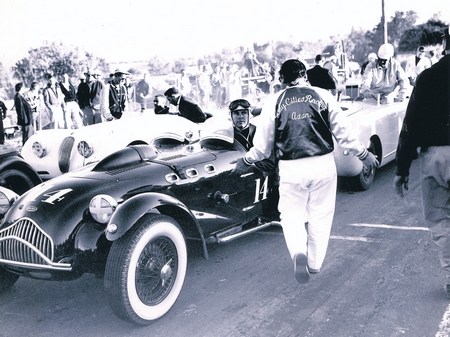
By Bill Pollack
Every time the number fourteen Allard raced it always started on the pole as the fastest qualifier. I don't think I really appreciated just how important that really was until years later. Thinking about it I'm not sure how I really accomplished that. It didn't seem to matter where we raced, the car was just scary fast compared to other cars in the field.
Being on the poll was always a little frightening because you have the entire field behind you, thousands and thousands of horsepower all screaming to go and if for some reason I stalled or some other stupid thing, it would be a terrible mess.
I know that when I was in front and the starter would give us the signal to start your engines there was always that awful moment when you thought God I hope the battery isn't dead. After the engine roared to life I've probably put the car in 1st gear at least 5 or 6 times just to make sure I was really in 1st gear. Sometimes I would actually let the clutch out just a little bit to make doubly sure that I was in number 1 slot. Of course, that was only the beginning.
My adrenal glands had probably been asleep for weeks or months since my last race and it was a rude awakening when the clutch came out and the car burst forward in a blinding explosion of speed. For some reason my vision immediately narrowed down to the front wheels and the road directly in front of me with little or no indication of what might be in my periphery. I don't think I was really aware of who was chasing me until at least the 2nd or 3rd corner had been negotiated without any serious mishap. Finally, I probably took a deep breath or let one out that I had been holding since the start of the race, and took a look to see who was back there. It was no surprise when it was usually Phil Hill.
I've never really had a chance to talk to other drivers about what it's like to sit in front and lead a race from pole to pole or from start to finish. The pressure which is enormous at the beginning of the race gradually diminishes as you complete each lap without serious actions bordering on dumb. There were moments when only you and no one else realizes that you had probably made a very small error and you simply told yourself don't even think about doing that again. It might have been experimenting with a slightly different line on a corner or changing the breakpoint for slow down by 5 or 10 feet. You quickly learn that the once you're in front this is not a good time or a place to experiment with how to go faster. After all, you're in front, what more do you want, all you have to do is stay there and everything should work out to your satisfaction.
People often commented to me about how difficult it must have been to drive the Allard, which they assumed was a bad handling car. The people who made those comments had never driven that car so I always took them with a grain of salt. But it wasn't until I drove several other Allards and then the black number 14 that I realize how much minute care and preparation went into that particular car. It was a number of adjustments and modifications that were made that resulted in the handling characteristics of that car being far superior to any other Allard I ever drove. Tom Carstens, in fact, had won a championship in midgets so he was well equipped to set up a car. Tom Carstens and Dave Fogg, his partner, were a team that was hard if not impossible to beat.
These days for a couple of hundred thousand dollars you can buy something from Italy, Germany or Great Britain that will go fast and is fun, but I will put up the Allard up against them. The Allard in terms of fun would be at the top.
Here's a few video clips of Bill Pollack promoting his racing memoirs, Red Wheels and White Sidewalls with Bob Schmitt. Bill has led a long and full life...with that he has accumulated many stories, most of which are true (we think).
In honor of the reprinting of Bill Pollacks racing memoirs, Red Wheels and White Sidewalls, we are reprinting our review of the book from issue #40 (Spring 2004). To buy a copy of the book, you can go to Amazon or to Bill's publisher, Brown Fox Books. Enjoy!
----------
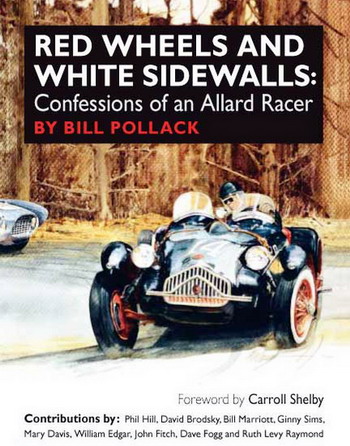
Many Allard enthusiasts got their initial inspiration from Tom Carsten’s immaculate white-walled, Cad-powered J2. Bill Pollack had the honor of piloting that imposing mass of adrenalin, testosterone, and charisma to outright victories in each of its five outings in 1951 and 1952. Bill continued his amateur racing activities for another 5 years after that car was destroyed in a post-race accident at Pebble Beach in 1953. During those years, he earned 18 more “podium” (in F1 parlance) finishes in 44 races.
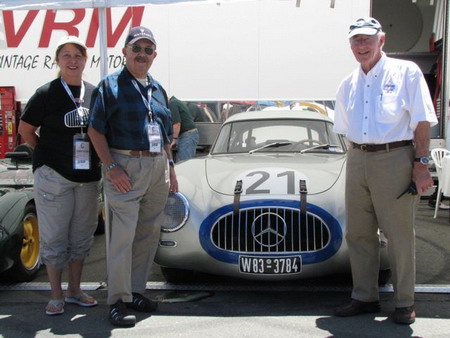
More than 340 historic cars ran in 15 racing groups at the 3rd annual Sonoma Historic Motorsports Festival at Infineon Raceway on the first weekend of June. This year’s theme was “Moments in Time: a Celebration of the History of Motorsports”. Bill Pollack, winner of the 1952 Golden Gate Park Road Races driving a Cadillac-Allard J2, was honored as Grand Marshal.
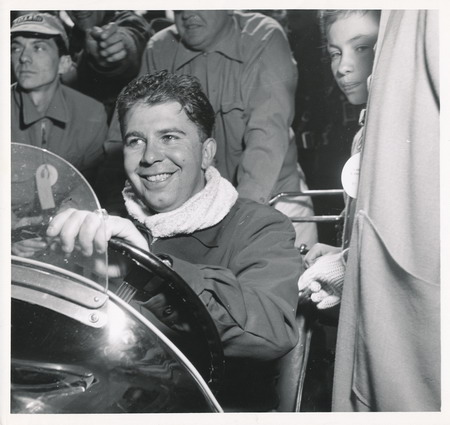
The following is a imaginative look at what an Allard might be like today. This concept is brought to us by none other than famed Allard racer Bill Pollack (seen above winning the 1950 Pebble Beach Road Race). You can imagine the impact that racing these beasts has had on Mr. Pollack...where he still imagines them tearing up the tracks and turning the automotive world inside out. Thank you Bill!
I have often wondered what prompted Sydney Allard, to build a sports car. In the late 30s and 40s he was involved in a sport known as “Trials”. It was very popular in Great Britain. The trials consisted of 2 men, in a small car trying to negotiate deep mud. Often, the participants would find themselves heavily mired in an endless sea of the sticky stuff. Mostly, the cars were Austin 7’s or the like, with tiny engines, low power and little to say for themselves. The enthusiasts, would strip the fenders, lights, windshields etc. to lighten the cars as much as possible. I am sure, that Allard quickly noticed that those cars with the somewhat larger engines probably did better.
By Bill Pollack
On September 10th twenty-two Allards assembled in this small village in upstate New York. They came from all over the United States, Canada and Great Britain with individuals from as far away as New Zealand. The gathering was to celebrate the victory sixty years ago by a J2 Allard driven by Erwin Goldschmidt. Allards have long since been an endangered species. Many of these Allard owners purchased their cars twenty or more years ago and the vehicles had become a part of the family. This exceptional group of people shared the Glen and its magnificent racing machines from vintage Sprites to 600 horsepower McLarens. As a guest of the Allard Owner’s Club I was privileged to experience this grand event. The following are some of my recollections of three exciting days.
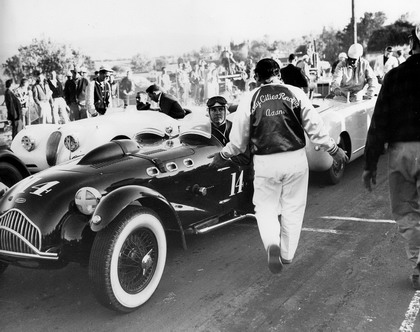
By Bill Pollack
A thousand years ago I was racing a very crude but powerful machine called an Allard. Mr. Allard had the crazy notion that he could sell a car without an engine. This may be the answer for Detroit. It would certainly drop the cost of an Escalade and qualify it as a ”No Emissions” vehicle.